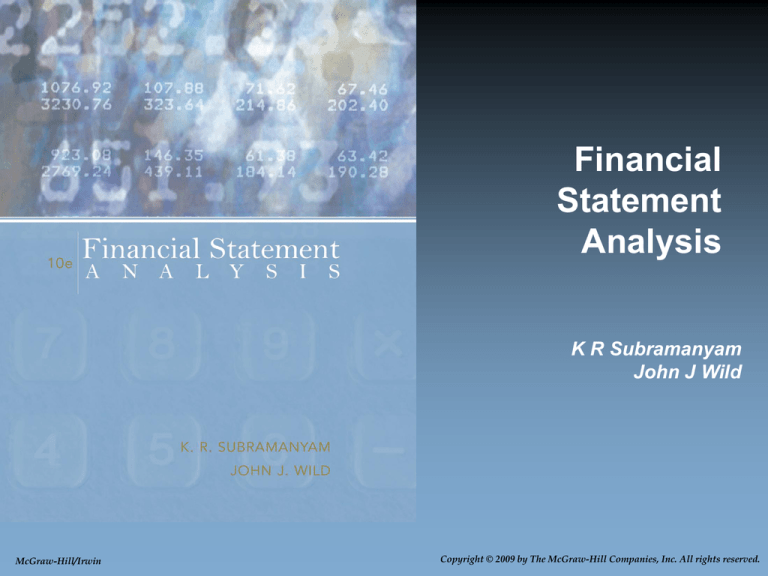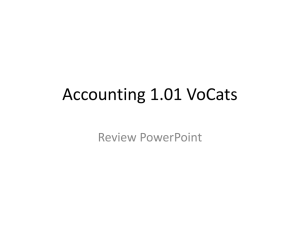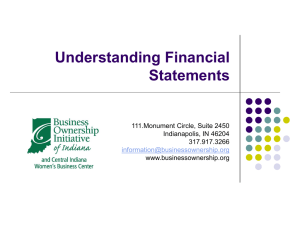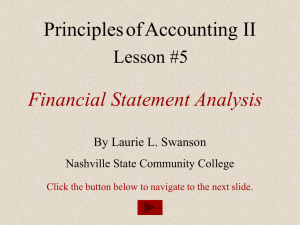
Financial
Statement
Analysis
K R Subramanyam
John J Wild
McGraw-Hill/Irwin
Copyright © 2009 by The McGraw-Hill Companies, Inc. All rights reserved.
Overview of Financial
Statement Analysis
1
CHAPTER
6-2
6-3
Information Sources for Analysis
Quantitative
Financial Statements
Qualitative
Management discussion & Analysis
Chairperson’s Letter
Industry Statistics
Press Releases
Economic Indicators
Financial press
Regulatory filings
Vision/Mission Statement
Trade reports
Web sites
6-4
Business Activities
Investing
Activities
Planning
Activities
Financial
Activities
Operating Activities
Revenues and expenses from providing
goods and services
6-5
Financial Statements Reflect Business Activities
Planning
Investing
Operating
Current:
•
•
•
•
Cash
Accounts Receivable
Inventories
Marketable Securities
Noncurrent:
•
•
•
Land, Buildings, &
Equipment
Patents
Investments
Sales
• Cost of Goods Sold
• Selling Expense
• Administrative Expense
• Interest Expense
• Income Tax Expense
•
Balance Sheet
Current:
•
•
•
•
•
•
Net Income
Cash Flow
Statement of
Cash Flows
Notes Payable
Accounts Payable
Salaries Payable
Income Tax Payable
Noncurrent:
•
Income statement
Assets
Financing
Bonds Payable
Common Stock
Retained Earnings
Liabilities & Equity
Balance Sheet
Statement of
Shareholders’ Equity
6-6
Major aspects of financial statement analysis
1. Profitability analysis
2. Credit analysis
3. Cash flow analysis
Basic analysis
4. Market measures
5. Financial distress and bankruptcy
analysis
Special analysis topics
6. Financial forecast
7. Equity valuation
Prospective analysis
6-7
Analysis Process
STEP 1
Identify
analysis
purposes
STEP 2
Identify
analysis
aspects
STEP 3
Collect
data
STEP 4
Process
data
STEP 5
Summarize
& discuss
results
6-8
Comparative analysis
8
• Why we need to compare?
• What we need to compare?
– Period-to-period
– Firm-to-firm
– Division-to-division
• Difference types:
– In dollars:
– In percentages:
∆A = A1 – A0
A1
x 100 (%)
A0
6-9
Horizontal analysis
To compare a company’s financial position
and performance between periods.
Time
6-10
Trend analysis
Trend analysis is used for comparison of the same
item over a significantly long period to detect
general pattern of a relationship between associated
factors and project the future direction of this
pattern.
10
6-11
Trend analysis
280%
260%
240%
220%
200%
180%
160%
140%
120%
100%
2007
2008
2009
2010
2011
11
6-12
Vertical analysis
Technique for identifying relationship between
items in the same financial statement by
expressing all amounts as the percentage of
the total amount taken as 100 (a common-size
financial statement).
6-13
Common-size graph
13
Other gains
Income tax
0.2%
Revenues1.4%
Interest
Cost
of goods sold
expense
Selling
1.20% and administrative
Net interest
Income taxes
Selling &
Other gains
administrative
expenses
Net earnings
24.6%
Net income per share
2007
100.0%
Net Income
69.2
3.6%
24.7
1.2
1.4 Costs of
0.2 revenue
69.0%
3.6
6-14
Common-size Balance sheets
Sears
%
Account payables
8,021
20.7%
Short-term loans
7,769
20.1%
Total short-term liabilities 15,790
40.8%
Long-term debts
13,071
33.8%
Other long-term liabilities
3,977
10.3%
Total long-term liabilities 17,048
44.1%
Total liabilities
32,838
84.9%
0.0%
Common stocks
3,921
10.1%
Retained earnings
4,158
10.7%
Treasury stocks
(2,217)
-5.7%
Total equity
5,862
15.1%
Total liabilitites & equity
38,700 100.0%
Wal-Mart
%
13,319
29.3%
1,141
2.5%
14,460
31.9%
9,674
21.3%
2,747
6.1%
12,421
27.4%
26,881
59.2%
0.0%
809
1.8%
18,167
40.0%
(473)
-1.0%
18,503
40.8%
45,384
100.0%
J.C. Penney
%
4,271
18.2%
1,866
7.9%
6,137
26.1%
6,986
29.7%
3,013
12.8%
9,999
42.6%
16,136
68.7%
0.0%
3,292
14.0%
4,114
17.5%
(49)
-0.2%
7,357
31.3%
23,493
100.0%
6-15
Common-size balance sheets
Sears
Cash
Receivables
Inventories
Other current assets
Total current assets
358
20,178
5,044
5,102
30,682
PP&E
Investments
Goodwill
Other long-term assets
Total long-term assets
Total assets
6,414
0
0
1,604
8,018
38,700
%
0.9%
52.1%
13.0%
13.2%
79.3%
0.0%
16.6%
0.0%
0.0%
4.1%
20.7%
100.0%
Wal-Mart
%
1,447
3.2%
976
2.2%
16,497
36.3%
432
1.0%
19,352
42.6%
0.0%
23,606
52.0%
0
0.0%
0
0.0%
2,426
5.3%
26,032
57.4%
45,384
100.0%
J.C. Penney
%
287
1.2%
4,892
20.8%
6,162
26.2%
143
0.6%
11,484
48.9%
0.0%
5,329
22.7%
1,774
7.6%
3,500
14.9%
1,406
6.0%
12,009
51.1%
23,493
100.0%
6-16
In mil. US$
2000
Account
receivables
17.301
Inventories
5.618
Total assets
36.889
2002
2003
2004 …
28.155 30.759
1.956
4.912.
5.335
2001
2010
2011
2012
1.239
689
695
635
5.549
8.951
8.407
7.558
44.317 50.409 27.723 22.474
24.360
21.381
19.340
5.115
6-17
1 Net sales
2 Cost of goods sold
3 Gross profit
4 Finance revenue
5 Finance expenses
Interest expense
6 Selling expenses
7 Administrative expenses
8 Operating profit
9 Other gains
10 Other losses
11 Net other gains (losses)
12 Profit before tax
13 Income tax expense
14 Profit after tax
Vinaconex
Common-size Income statement
For the year ended Dec. 31, 2009
2009
2008
VND mil.
%
VND mil.
%
3,849,352 100.0% 2,848,155 100.0%
3,574,803 92.9% 2,767,680 97.2%
274,549
7.1%
80,475
2.8%
802,940 20.9% 199,225
7.0%
581,012 15.1% 112,749
4.0%
356,843
9.3%
34,061
1.2%
2,770
0.1%
54,100
1.9%
331,893
8.6% 226,096
7.9%
161,814
4.2% (113,245) -4.0%
968,632 25.2% 423,067 14.9%
574,717 14.9%
3,705
0.1%
393,915 10.2% 419,362 14.7%
555,729 14.4% 306,117 10.7%
140,464
3.6%
925
0.0%
415,265 10.8% 305,192 10.7%
6-18
Ratio analysis
• To evaluate relationships among financial
statement items
• Four groups:
– Liquidity
– Solvency
– Efficiency
– Profitability
6-19
Equity Valuation
Valuation - an important goal of many types
of business analysis
Purpose: Estimate intrinsic value of a
company (or stock)
Basis:
Present value theory (time value of
money)
6-20
Present value theory
P = Fn
1
n
(1 + r)
P: Present value
Fn: Future value at period
n
A: Annual cash flows (from
period 1 to period n)
r: discounted rate
1
1
P=Ax x 1n
r
(1 + r)
6-21
Equity valuation –
Residual Income Model
Investors should pay more than book value if actual income is
higher than expected and less than book value if actual income is
lower than expected.
Expected Income = Required rate of equity x Book value of equity
Residual Income = Actual Income – Expected Income
Fair value of Equity = Book value of Equity +
PV{Expected Residual Incomes}
6-22
Equity valuation –
Residual Income Model
BV is the book value at the end of period t
Rit+n is the residual income in period t + n [defined as
net income, NI, minus a charge on beginning
book value, BV, or RIt = NIt - (k x BVt-1)]
k is the cost of capital
E refers to an expectation
t
6-23
Example
In VND mil.
2013
2014
2015
2016
2017
2018
Net income
609
628
639
702
773
773
Dividends
357
433
370
407
448
448
Beginning book value of
equity
2917 3169 3364 3633 3928 4253
Cost of equity 13%
23
6-24
Example
2013
2014
2015
2016
2017
2018
1. Beginning book value of equity BVE
2. Required Income
(rE= 13%)
3. Projected Income
4. Residual Income
5. Discounted factor (rE = 13%)
6. PV {RI2013→2018}
Fair value of equity VE =
24
6-25
Equity valuation –
Dividend model
Vt is the value of an equity security at time t
Dt +n is the dividend in period t+n
k is the cost of capital
E refers to expected dividends
6-26
Equity Valuation –
Free cash flow to equity model
FCFEt+n is the free cash flow to equity in the period t + n
[often defined as cash flow from operations less capital
expenditures]
k is the cost of capital
E refers to an expectation










